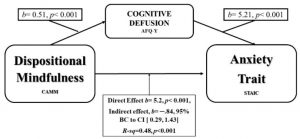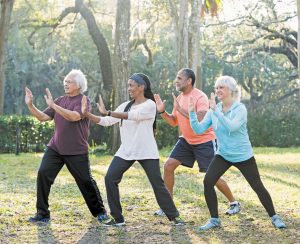Improve Blood Fat Levels in Type 2 Diabetes with Yoga
By John M. de Castro, Ph.D.
“Yoga can do more than just relax your body in mind — especially if you’re living with diabetes. Certain poses may help lower blood pressure and blood sugar levels while also improving circulation, leading many experts to recommend yoga for diabetes management.” – Healthline
Diabetes is a major health issue. It is estimated that 30 million people in the United States and nearly 600 million people worldwide have diabetes and the numbers are growing. Type II Diabetes results from a resistance of tissues, especially fat tissues, to the ability of insulin to promote the uptake of glucose from the blood. As a result, blood sugar levels rise producing hyperglycemia. Diabetes is heavily associated with other diseases such as cardiovascular disease, heart attacks, stroke, blindness, kidney disease, and circulatory problems leading to amputations. As a result, diabetes doubles the risk of death of any cause compared to individuals of the same age without diabetes.
Type 2 diabetes is a common and increasingly prevalent illness that is largely preventable. One of the reasons for the increasing incidence of Type 2 Diabetes is its association with overweight and obesity which is becoming epidemic in the industrialized world. A leading cause of this is a sedentary life style. Unlike Type I Diabetes, Type II does not require insulin injections. Instead, the treatment and prevention of Type 2 Diabetes focuses on diet, exercise, and weight control. Recently, mindfulness practices have been shown to be helpful in managing diabetes. A mindfulness practice that combines mindfulness with exercise is yoga and it has been shown to be helpful in the treatment of Type II Diabetes.
In today’s Research News article “Efficacy of a Validated Yoga Protocol on Dyslipidemia in Diabetes Patients: NMB-2017 India Trial.” (See summary below or view the full text of the study at: https://www.ncbi.nlm.nih.gov/pmc/articles/PMC6963794/), Nagarathna and colleagues recruited a stratified sample of adult patients with Type 2 Diabetes and assigned them to receive yoga training that was specifically designed for the treatment of diabetes and consisted of 9 days of 2-hour training sessions followed by daily 1-hour practice at home guided by DVD. They were measured before training and 3 months later for body size and blood was drawn and assayed for fasting blood glucose, glycated hemoglobin (HbA1c), total cholesterol, triglycerides, LDL, VLDL, and HDL.
They found that in both male and female patients with Dyslipidemia (high blood fat levels) there was a significant decrease in the total blood fat levels produced by participation in the yoga program. This included significant decreases in triglycerides, LDL, and VLDL. These improvements were significantly greater in patients from rural areas than those from urban areas. Around two thirds of the patients with Dyslipidemia had their blood fat levels returned to normal levels after yoga practice.
These results are interesting but the lack of a comparison (control) conditions limits their significance. But prior controlled studies have shown the yoga practice produces significant improvements in the symptoms of Type 2 Diabetes. So, the present results likely also reflect the effects of yoga practice and not a confounding variable.
The results suggest that yoga practice can reduce Dyslipidemia in Type 2 Diabetes patients. It would be useful to follow up these patients to see if the treatment improves the patients’ overall health and reduces heart disease. The reduction in Dyslipidemia would predict such benefits.
So, improve blood fat levels in Type 2 Diabetes with yoga.
“findings suggest that yogic practices may promote significant improvements in several indices of importance in [Type 2 Diabetes] management, including glycemic control, lipid levels, and body composition.” – Kim Innes
CMCS – Center for Mindfulness and Contemplative Studies
This and other Contemplative Studies posts are also available on Google+ https://plus.google.com/106784388191201299496/posts and on Twitter @MindfulResearch
Study Summary
Nagarathna, R., Tyagi, R., Kaur, G., Vendan, V., Acharya, I. N., Anand, A., … Nagendra, H. R. (2019). Efficacy of a Validated Yoga Protocol on Dyslipidemia in Diabetes Patients: NMB-2017 India Trial. Medicines (Basel, Switzerland), 6(4), 100. doi:10.3390/medicines6040100
Abstract
Background: Dyslipidemia is considered a risk factor in Type 2 diabetes mellitus (T2DM) resulting in cardio-vascular complications. Yoga practices have shown promising results in alleviating Type 2 Diabetes pathology. Method: In this stratified trial on a Yoga based lifestyle program in cases with Type 2 diabetes, in the rural and urban population from all zones of India, a total of 17,012 adults (>20 years) of both genders were screened for lipid profile and sugar levels. Those who satisfied the selection criteria were taught the Diabetes Yoga Protocol (DYP) for three months and the data were analyzed. Results: Among those with Diabetes, 29.1% had elevated total cholesterol (TC > 200 mg/dL) levels that were higher in urban (69%) than rural (31%) Diabetes patients. There was a positive correlation (p = 0.048) between HbA1c and total cholesterol levels. DYP intervention helped in reducing TC from 232.34 ± 31.48 mg/dL to 189.38 ± 40.23 mg/dL with significant pre post difference (p < 0.001). Conversion rate from high TC (>200 mg/dL) to normal TC (<200 mg/dL) was observed in 60.3% of cases with Type 2 Diabetes Mellitus (T2DM); from high LDL (>130 mg/dL) to normal LDL (<130 mg/dL) in 73.7%; from high triglyceride (>200 mg/dL) to normal triglyceride level (<200 mg/dL) in 63%; from low HDL (<45 mg/dL) to normal HDL (>45 mg/dL) in 43.7% of T2DM patients after three months of DYP. Conclusions: A Yoga lifestyle program designed specifically to manage Diabetes helps in reducing the co-morbidity of dyslipidemia in cases of patients with T2DM.
https://www.ncbi.nlm.nih.gov/pmc/articles/PMC6963794/









